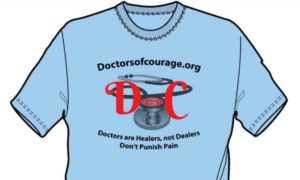This is part 4 of a 4 part exposure of the collaboration against doctors by government agencies, private insurance companies, and law enforcement, called HFPP (Healthcare Fraud Prevention Partnership). The goal of this collaboration is to charge doctors with fraud based on sharing patient data across multiple groups, and then analyzing the data to identify the easiest doctors to target. The data is manipulated to be used against the doctor in court. Some of the manipulation is creating charges for crimes that didn’t occur. Tax dollars are then used to prosecute these doctors in federal court, and the private insurance companies reap the harvest.
This segment will discuss the priority actions identified on the white paper for the data search for providers to attack.
DRUG UTILIZATION REVIEWS
The HHS OIG recommends broadening drug utilization review programs to include more drugs that are susceptible to fraud, waste, and abuse. They did this bringing in benzodiazepines when prescribed with opioids or the threesome combination: opioids, benzodiazepines and Soma, a muscle relaxant. Now when the government isn’t interfering with medical care, doctors know that prescribing these medicines together has been done safely and effectively for 20+ years. It has only been since the government interference causing increased anxiety in pain patients that these drugs have been overused and cause potentially dangerous side effects. But the government uses the result of their own interference to attack more doctors trying to treat more patients with increased anxiety. And now they want to expand this oversight with more drugs to obviously target more physicians.
How HFPP Conducts Drug Utilization Reviews
- Report routinely based on the contents of the data warehouses as a chief strategy for investigations.
- Provide periodic updates to the partners’ SIUs (Special Investigation Unit). The SIUs perform analytics, generate leads for investigation, and monitor activities such as the prescribing patterns and dispensing patterns of their providers. SIUs identify aberrancies such as high prescribers, including pain management providers, and high users of opioids. The data in claims records also allow SIUs to track the movements of patients suspected of abusing opioids or having an OUD.
- Produce a monthly report that shows how many providers have prescribed at least 30 controlled substances or where more than 30 percent of all the provider’s prescriptions are for controlled substances. The provider is then reviewed to determine whether they are prescribing appropriately. Dose levels are reviewed and referred to the team when the limits are exceeded.
- Define levels of use for morphine-equivalent doses for their providers and the referral of cases to the quality team when the limits were exceeded.
- Use claim system edits for high utilizers that require medical justification documentation before a claim is paid.
- Use utilization reviews to identify and monitor pain management providers with a high rate of prescriptions.
- Conduct retrospective drug utilization reviews that notify physicians of safety risks identified through the review and provide appropriate recommendations for management by a letter. Patients are selected for the review based on safety risks that are categorized as clinical rules.
HFPP PRIORITY ACTION FOR APPROACH 2
Encourages the use of data collection using personal patient information to identify opioid prescribing in order to target providers. Then refer these providers for potential “education, administrative sanction, or law enforcement referral as appropriate”. For the most part, they get indicted by the feds. After all, why communicate with the provider that their actions could result in charges when the law being used states.
18 U.S. Code § 1347- Health Care Fraud:
(b) With respect to violations of this section, a person need not have actual knowledge of this section or specific intent to commit a violation of this section.
When you’re going after the money, just charge the fools.
And so, to that end, comes
HFPP APPROACH 3: INFORMATION SHARING WITHIN THE HFPP TO IDENTIFY OPIOID MISUSE
HFPP PRIORITY ACTION FOR APPROACH 3
Collaborate efforts to develop and widely disseminate effective strategies to identify providers whose opioid prescribing patterns fail to comply with quality indicators.
Description and characterization of the opioid prescribing environment.
In a study of the opioid prescribing environment, the HFPP can develop a set of algorithms to identify instances of prescribing that fall outside the guideline and classify these by risk of patient overdose, and risk of OUD.
Examples of non-guideline prescriptions include:
- Prescriptions made above a morphine milligram equivalent (MME) of 90 MME/day without titration
- Prescriptions of opioids concurrently with benzodiazepines
- Prescription of opioids with no justifying medical diagnosis
The data analysis can classify providers who inappropriately prescribe opioids and patients who receive inappropriate prescriptions by demographics, region, provider type, and patient diagnosis (or lack thereof).
Conclusions
The collaboration of government and private insurance companies to further attack providers treating chronic pain patients cannot be ignored. Basically, the government is simply bringing in more sources of potential victims in the illegal government overreach into medicine, using confidential patient information, sharing it between different insurance companies, none of the reviewers having medical knowledge, and then passing this patient information on to non-medical data analysis businesses for manipulation.
What Should Be Done?
Pie in the Sky:
 Doctors need to unionize. Medical associations already in existence—AMA, AAPS, need to work on creating union standards so that doctors can have a legal method to fight these forms of government/private attacks on the profession. If these organizations don’t do something to protect the profession, then they are part of the problem and probably in cahoots with the government in their own monopoly way.
Doctors need to unionize. Medical associations already in existence—AMA, AAPS, need to work on creating union standards so that doctors can have a legal method to fight these forms of government/private attacks on the profession. If these organizations don’t do something to protect the profession, then they are part of the problem and probably in cahoots with the government in their own monopoly way.- Doctors need to opt-out of the insurance companies involved in this blatant attack on the profession for money. Patients need to support leaving insurance for their doctor’s visits. Staying in insurance for catastrophic health—hospital, surgery, etc, is fine. That’s what insurance was designed for. But it would be a lot cheaper and more income for the physician (a win-win) if doctors simply did cash for service in their office.
Linda Cheek is a teacher and disenfranchised medical doctor, turned activist, author, and speaker. A victim of prosecutorial misconduct and outright law-breaking of the government agencies DEA, DHHS, and DOJ, she hopes to be a part of exonerating all doctors illegally attacked through the Controlled Substance Act. She holds the key to success, as she can offset the government propaganda that drugs cause addiction with the truth: The REAL Cause of Drug Abuse.
Get a free gift to learn how the government is breaking the law to attack your doctor: Click here to get my free gift

